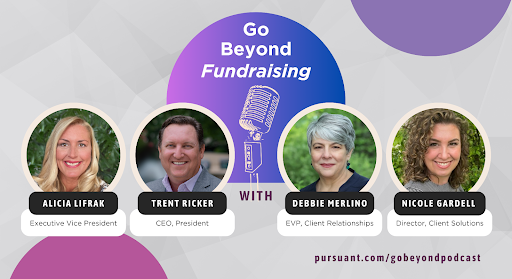Podcast | How Member Organizations Can Turn More Members Into Donors

Membership organizations are an interesting segment of the nonprofit world — “Join our club, and you’ll get XYZ benefits.” We see this in the arts and culture realm, especially. Think museums, zoos, theaters, and other places that rely on philanthropy to operate and offer a “visitation membership.”
These organizations often see support from three areas: members, donors, and member-donors.
- Members pay a monthly or annual fee for a special perk, like free admission to your museum or a discount in your store.
- Donors support you because they believe in your mission. They don’t necessarily visit your organization and aren’t interested in benefits.
- Member-Donors are both. They likely started as members and were effectively stewarded to becoming donors through enriching and engaging experiences.
Member-Donors are the goal. In this episode of the Go Beyond Fundraising podcast, Pursuant’s President Trent Ricker hosts a roundtable discussion with Debbie Merlino, Alicia Lifrak, and Nicole Gardell on how your membership organization can compel more members to take the next step and become active donors.
Marketing and Fundraising Teams Must Work Together
Most organizations are siloed, with marketing and fundraising teams working toward different goals. For membership organizations, marketing is likely focused on getting more individuals through the gate. Then, fundraising might sprinkle opportunities for them to give more throughout your venue — adopt an animal, buy a brick, etc.
Instead, consider membership the entry point to a larger conversation about your organization. Marketing and fundraising should work together to develop communications that, yes, outline membership benefits but also emphasize how each membership supports the work you’re doing in the community. And don’t be afraid to include other opportunities for them to give, whether by attending an upcoming event or becoming a monthly donor. The second ask can and should come in your welcome series.
By becoming a member, they’re becoming a part of your story — make sure they know this. Then, steward the member the way you would a donor and cultivate the member experience so that the difference between “member” and “visitor” is clear. They’re now part of a community.
When marketing and fundraising teams take a unified approach, they’ll increase both membership and donor satisfaction, leading to more long-term revenue for your organization.
Do you have a separate membership team as well? Get them involved, too. And make sure all three teams share data so they can make informed decisions about who to target with specific asks. For instance, someone who doesn’t renew their membership may be willing to support you in other ways.
Make the Most of Your Member Data
Speaking of data — make sure you’re collecting it at every point of the member experience:
- Did they sign up for a membership online or on-site?
- What exhibits are they going to?
- Do they take advantage of member benefits like exclusive lectures?
You can then use these insights to make projections about member behavior. For instance, members who visit your museum at least twice are more likely to renew their membership. And those who regularly renew their membership are more likely to upgrade to a member-donor.
Most of this data should be captured in your customer relationship management (CRM) tool. Of course, you can also ask members for additional information to help you build donor journeys and communications plans. Just be sure that you have a strategy for how that information will be used. If a member shares their phone number, they expect to hear from you. What messages will you send that will keep them engaged at the right pace and compel them to give more?
Similarly, if you don’t have a plan for your member data, don’t collect it. Otherwise, you’ll fall into a data overload trap, which only clutters your ability to work efficiently.
Finally, ensure your marketing, fundraising, and membership teams work toward shared key performance indicators (KPIs), objectives, and key results (OKRs). They should all know what to collect, what to measure, and what to communicate to reach their goals.
Remember, Stewardship Is Key
Membership in your organization is only the beginning. Just as you steward donors, members should be given opportunities to learn more about your good work. Craft every aspect of the member experience with care, respect, and gratitude to begin a relationship that leads to long-term support.
We’ve only scratched the surface. To hear the full discussion and get more advice for converting members into member-donors, listen to the full podcast: How Member Organizations Can Turn More Members Into Donors